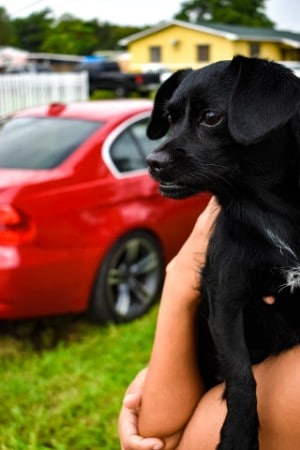Going on a long journey with a dog is difficult enough but things get much more complicated when you are travelling with a puppy.
And you can add another few layers of complexity when you are planning to drive a long distance with a puppy that you have just picked up from a breeder!
It is perhaps stating the obvious to say that this journey will require a terrific amount of planning and preparation as well as a touch of good fortune
When we undertake driving long distances with a puppy in cars, three factors combine to potentially create a perfect storm.
The puppy doesn’t know you, they are leaving their family and home and it will be one of the first times that they have travelled in a car.
If that isn’t a challenge, I would like to know what is!
[1] Tidy house and garden
A bit of a strange one to start with?!
Why start with the house and garden when the focus is on taking a journey 🙂
Make sure that your house and garden are puppy proof.
The rationale for this is that when you return with your puppy you won’t have time to pick things up off your floor as before you know it they will be in your puppy’s mouth.
But what do I mean by tidy?
Just make sure that the floors are clear of any clothing, shoes or valuable items such as laptops.
And that any electrical wires are out of sight.
The same goes for the garden.
In fact the garden should be the first place that you head towards on your return.
Make sure that it is clear of any poop (cat or dog) and other objects such as gardening tools
[2] Don’t do it alone.
If at all possible, don’t make a long journey with a puppy on your own: get yourself a “Wingman”.
Always travel with someone else, so that one person can concentrate on driving, the other on the puppy.
And if you are going to share the drive, make sure that the owner of the puppy sits with the puppy for the first leg so that they can bond.
If you do have to make the journey alone it will be infinitely harder.
[3] Crate or lap
Strictly speaking in both the US and UK dogs should not travel in a car without being restrained.
This can mean a number of different things.
From travelling in the backseat with a lead on (that is attached to some part of the car), to travelling in a crate, to travelling in the boot secured behind a dog grate (in estate cars or station wagons.)
This requirement is for the whole of the UK, as defined by Section 56 to 58 of the Highway Code.
Things are less clear in the US.
As of this moment, only six states require a dog to be restrained; Connecticut, Maine, Massachusetts, Minnesota, New Hampshire, Rhode Island.
For puppies, most people opt to place their puppy in a pet carrier or crate on the backseat, so that someone can sit next to them and keep an eye on them.
This enables someone to provide comfort while still keeping the puppy safe.
But what do you do if you have a puppy which is visibly distraught and continually whining and even shaking with fear?
Some people resort to having the puppy on their lap, which works as long as the puppy falls asleep.
[4] Keeping calm
The next tip is probably the hardest one to organise and manage.
And that is to keep calm.
However chaotic the trip may get (and with a puppy that might urinate, defecate, vomit or whine relentlessly) it is quite likely, you should always try and keep calm.
And by this I mean never raising your voice, making sudden aggressive movements or god forbid, discipling your puppy with a smack.
None of this will make your puppy less likely to stop- whining, vomiting or defecating.
In fact it will likely have the opposite effect.
Losing your temper only shows that you have lost control.
And the best way of keeping calm is by planning and preparing.
Because like a military operation, you will need lots of equipment.
[5] Equipment
When you start your journey you need to know that you have thought of every eventuality and that you have bought for it.
We have already mentioned the crate- just make sure that it is the right size for your puppy.
There is plenty of advice about buying the correct size crate for a puppy.
It should be big enough but not too big. The most important things to think of are the gear that you will need to clear up any kind of mess- wipes, gloves and poop bags or nappy bags.
And make sure that you have enough! It is better to bring more wipes than you need rather than less.
The next most important item to bring is a lead- I am presuming that your puppy will have a collar on but this is something to double check
Some would say that it needs to be attached to your dog for the whole journey but I think that it is OK to put it on before any door is opened!
The next important piece of equipment to include if you are picking up your puppy from the breeders, is a cloth of a blanket that smells of their Mum or of the litter.
Having a familiar smell in a very unfamiliar environment should help to calm your puppy down, making the journey easier for everyone.
[6] Food and water
The next issue to think about and plan for is whether to bring any food for your puppy.
This is actually quite a complicated issue to wrap your head around.
There are loads of different things to consider about this issue and it is easy to get in a muddle about it.
It all depends on how long your journey is and how old your puppy is.
Most puppies that are being picked up from breeders are about eight weeks old.
And an eight week old puppy should be eating about four times a day, which is about every four hours.
In an ideal world, you want to pick your puppy up a couple of hours after their first meal, which means before you start your journey your puppy has been to the toilet and emptied their stomach.
It also means that they are only a couple of hours away from their next feed.
As a one off, they can miss their next meal and not need to be fed during the journey as long as you will be home by the time they should have their third meal of the day.
To keep things simple, this gives you a six hour journey time.
If you can complete your journey (with all the stops) within six hours then you shouldn’t feel pressured to feed them en route.
However, if your journey time is over six hours, then take some food to feed to your puppy.
Make sure it is the same brand and type of food as they have been eating up to this point.
Either way, make sure you pack some food just in case your journey is delayed.
Your puppy might not need to be fed on a long journey but they should always have access to water- which you should offer to them at every stop.
Now, lots of puppies who have been picked up from the breeders have no interest in food or water as they find the journey too exhausting.
But just how often should you stop on your journey?
[7] Rest stops
The biggest factor in how many rest stops that you should make is that an eight week old will need to go to wee every two- three hours.
And after around three hours most drivers could do with stopping and “switching off” for a time as well.
But rest stops aren’t without the odd risk here and there.
For instance, it might be difficult to find a quiet and clean patch of grass to take your puppy on at the rest stop that you have chosen.
It needs to be quiet so that your puppy isn’t spooked by any sudden loud noises from passing traffic or groups of people.
And remember it needs to be clean and free from other dogs because your puppy won’t have had all of their immunisations.
And please make sure that before you open any doors, your puppy has a collar and lead on.
Another risk of stopping is to not leave your puppy unattended in the car at any point.
Not only might they be at risk of overheating (in the car) if you take longer than expected going to the restroom and buying a coffee but they could also be stolen.
It makes most sense, if there are two of you in the car, to take it in turns to go in and use the facilities.
And as I come to the end, I want to talk about the option of paying for someone else to do it.
[8] Pet Taxis
If everything up until this point has overwhelmed you and freaked you out, there are companies out there who will drive your puppy on a long journey for you.
These services are not cheap and depending on the distance travelled it might cost hundreds or thousands of pounds but if you definitely have the money and definitely don’t need the stress, then it might be the way to go.
My sister in law a few months back paid for a company to drive her new 8 week old Golden Retriever puppy on a six hour journey and everything went incredibly smoothly.







